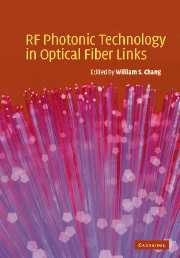Book contents
- Frontmatter
- Contents
- List of contributors
- Introduction and preface
- 1 Figures of merit and performance analysis of photonic microwave links
- 2 RF subcarrier links in local access networks
- 3 Analog modulation of semiconductor lasers
- 4 LiNbO3 external modulators and their use in high performance analog links
- 5 Broadband traveling wave modulators in LiNb03
- 6 Multiple quantum well electroabsorption modulators for RF photonic links
- 7 Polymer modulators for RF photonics
- 8 Photodiodes for high performance analog links
- 9 Opto-electronic oscillators
- 10 Photonic link techniques for microwave frequency conversion
- 11 Antenna-coupled millimeter-wave electro-optical modulators
- 12 System design and performance of wideband photonic phased array antennas
- Index
- References
12 - System design and performance of wideband photonic phased array antennas
Published online by Cambridge University Press: 06 July 2010
- Frontmatter
- Contents
- List of contributors
- Introduction and preface
- 1 Figures of merit and performance analysis of photonic microwave links
- 2 RF subcarrier links in local access networks
- 3 Analog modulation of semiconductor lasers
- 4 LiNbO3 external modulators and their use in high performance analog links
- 5 Broadband traveling wave modulators in LiNb03
- 6 Multiple quantum well electroabsorption modulators for RF photonic links
- 7 Polymer modulators for RF photonics
- 8 Photodiodes for high performance analog links
- 9 Opto-electronic oscillators
- 10 Photonic link techniques for microwave frequency conversion
- 11 Antenna-coupled millimeter-wave electro-optical modulators
- 12 System design and performance of wideband photonic phased array antennas
- Index
- References
Summary
Introduction
The application of RF photonics to RF antenna systems is a thread of development that runs parallel to the development of high performance analog links and components. This chapter deals with the promise of high performance analog photonic links applied to the field of phased arrays or RF manifolds.
In the early 1980s RF design engineers began to view photonics as a promising system option because of the possibility of modulating RF signals onto an optical carrier and the advantage of fiber optic transmission for low loss over large distances. As a cable replacement, fiber optics offers extremely wide bandwidth with no dispersion, significant weight reduction, loss reduction over a distance greater than 100 m, and immunity from electromagnetic interference or cross coupling. The challenges for achieving cable replacement have been lowering the overall conversion loss, and achieving high spur-free dynamic range, and high dynamic range.
In the late 1980s the focus shifted to applying photonics to antenna systems, as the development of optical networking techniques suggested the possibilities of routing optical modulated carriers to perform different RF functions. In particular the systems designers were interested in the possibility of performing several RF functions with photonics, namely beam steering, null steering, channelization, and local oscillator distribution over an optical manifold. To implement a photonic architecture, we assume the existence of high fidelity links and networks and device schemes for signal gathering, beam control, phase steering and true time delay steering, multichannel remoting, and pre-processing in the optical domain.
- Type
- Chapter
- Information
- RF Photonic Technology in Optical Fiber Links , pp. 377 - 400Publisher: Cambridge University PressPrint publication year: 2002
References
- 1
- Cited by



